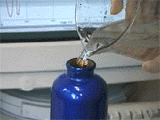| 9 | Cold water in an insulated drinking bottle, sitting in a warm room |
|
|
| Main | Very cold water is poured into a drinking bottle which is insulated. A magnetic stirrer is used to make sure the water is always well mixed. It is left standing to warm up. The temperature of the water and of the environment are recorded as functions of time. More…

|
Photographs |
|
| Movies | |
| Data files | |
| Models | |
| |
| Sections | |
|
| |
| Description | DESCRIPTION OF EXPERIMENT |
| Experiment | Very cold water is poured into a drinking bottle which is insulated. A magnetic stirrer is used to make sure the water is always well mixed. It is left standing to warm up. The temperature of the water and of the environment are recorded as functions of time. Cold water is prepared by adding and melting ice. The temperature probe is inserted through the hole at the top. The top is then insulated with a thick layer of cotton.
 
|
| Dimensions | Inside diameter of bottle: 7.0 cm Height of container: 15.2 cm Thickness of rubber foam insulation: 6.0 mm
|
| |
| Sections | |
|
| |
| Assignment | A POSSIBLE PATH THROUGH THE INVESTIGATION… |
| Basics | Investigate the experiment, make sure you understand the setup of the system and the initial conditions. Plot the data to get a feeling for the dynamical process. Estimate time constants of the processes. Create a word model for the system and its processes. Create a formal dynamical model (start with the model of Investigation 8). Import data, simulate the model and determine the parameters of the model by comparing simulation and experimental data.

|
Particulars | Compare model and virtual and/or experimental data to determine the conductivity of the insulating material taking a value of 12 W/(K·m^2) for the outside heat transfer coefficient. Vary the outside heat transfer coefficient and determine its influence upon the value of the conductivity. Having an uncertainty in the heat transfer coefficient, how uncertain is the determination of the conductivity?
|
| |
| Sections | |
|
| |
| Model | MODEL EQUATIONS AND MORE… |
| |
|
| |
| Sections | |
|
| |
| Questions | SOME SIMPLE QUESTIONS… |
| 1 | Would you say the container wall and the insulation act as a pure resistor or should you consider them as storage elements (like the water)? |
| 2 | How many different transfer layers are there between the water and the air? |
3 | If you represent the transition from water to air by a number of layers, how do you calculate the total thermal resistance of the transition zone? |
4 | Of the mantle, top, and bottom of the container, which one(s) should you include in your determination of the total (energy) conductance for the transfer from air to water? |
5 | If you use the entropy representation of the processes in your model, how do you calculate the entropy flux into the water from the (energy) conductance? |
6 | If the water is not stirred, which temperature do you expect the water to have after a very long time? |
7 | Water in the bottle and air in the room have the same temperature of 20°C. Now you change the temperature in the room according to half a period of a sine function (going from 20°C to 30°C and back to 20°C in about 8 hours). Sketch the response of the temperature of the water. |
8 | You put a thermometer into hot water. Does it show its temperature immediately without any delay? |
9 | What principles did you learn by doing this investigation? |
|
| |
| Sections | |
|
| |


